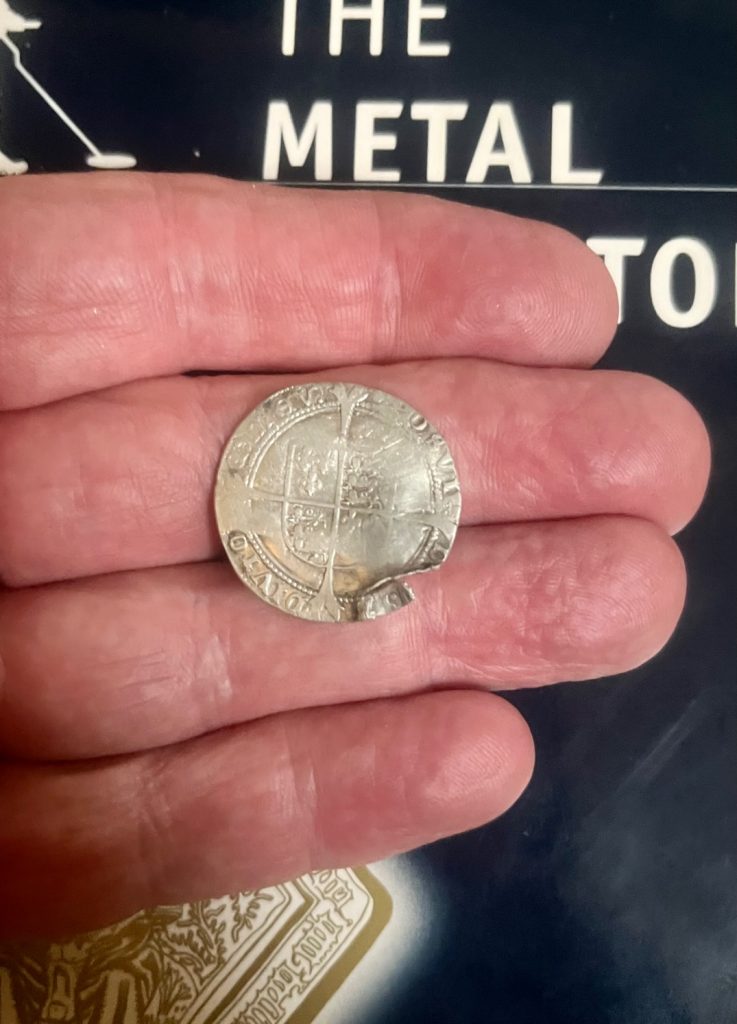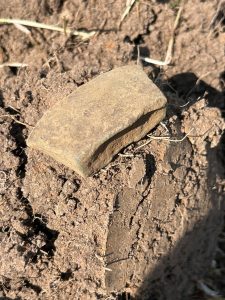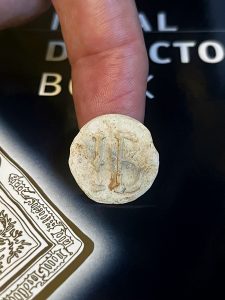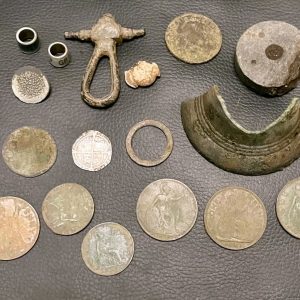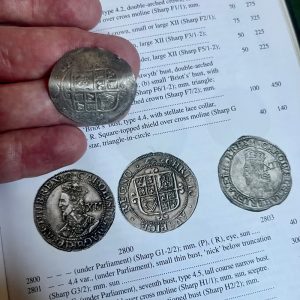
It was a warm summer’s evening when I decided to head out to one of my favourite fields for a bit of metal detecting. The sky was painted in soft hues of orange and pink as the sun began its slow descent, casting long shadows across the landscape. I’d been cooped up inside all day, and the prospect of spending a few hours outdoors with my trusty detector was just what I needed to unwind.
As I walked through the familiar gate and into the field, I took a deep breath, savouring the scent of freshly cut grass and wildflowers. The air was still warm, but a gentle breeze provided just enough cooling to make it comfortable. I could hear the distant lowing of cattle in the next field over and the cheerful chirping of birds settling in for the night.
I switched on my detector and began my slow, methodical sweep across the field. The rhythmic swinging of the detector and the soft beeps it emitted were almost meditative. I wasn’t finding much of interest at first, but that didn’t dampen my spirits. For me, metal detecting has always been as much about the experience of being outdoors and connecting with history as it is about the finds themselves.
As the evening wore on, I accumulated a small collection of odds and ends in my finds pouch. There were a few toasted Georgian copper coins, their details worn smooth by centuries in the ground but still recognisable by their size and colour. I also picked up a handful of buttons – some plain, some with intricate designs that hinted at the fashions of bygone eras. And of course, there was the usual assortment of lead fragments and other bits of metal for my ever-growing scrap collection. Each piece, no matter how small or seemingly insignificant, was a tangible link to the past, and I treated them all with care and respect.
Just as I was considering calling it a night, my detector gave off a signal that caught my attention. It wasn’t particularly strong or clear, but something about it made me pause. In this game, you learn to trust your instincts, and mine were telling me this was worth investigating.
I marked the spot and reached for my spade. With practiced ease, I cut a neat square of turf, just large enough to flip over. I always try to disturb the ground as little as possible – it’s important to me to leave the field as I found it. Once I’d removed the turf, I checked the hole with my detector. The signal was still there, a bit clearer now without the layer of grass muffling it.
Next, I pulled out my handheld pinpointer. This little tool helps narrow down the exact location of a find, making the retrieval process quicker and less damaging to both the item and the surrounding soil. The pinpointer indicated that the object was just below the surface. Excitement began to build – shallow finds are often the most interesting ones.
I set aside my digging tools and began to gently prise apart the soil with my fingers. It’s always tempting to rush in with the spade when you’re eager to see what you’ve found, but patience is key in this hobby. I’ve seen too many potentially valuable artifacts damaged by overzealous digging to make that mistake.
As I worked, I could feel something solid within the clump of earth. Carefully, I lifted it out, a ball of soil about the size of my fist. I began to break it apart gently, piece by piece. And then, suddenly, I caught a glimpse of something that made my heart race – the unmistakable gleam of silver.
As more of the object was revealed, I could hardly believe my eyes. It was a silver hammered coin, and a fair-sized one at that. In my part of the country, these aren’t exactly common finds, so coming across one is always a thrill. The coin was caked in mud, making it hard to discern any details, but even so, I could tell it was something special.
I tried to clean it a bit there in the field, but all I managed to do was smear more damp mud across its surface. From what little I could make out, I thought it might be an Elizabeth I sixpence. That would be a fantastic find in itself, but I knew better than to jump to conclusions. I’ve learned the hard way that it’s best to wait until you can properly clean and examine a find before getting too excited about its potential identity.
Carefully, I placed the coin in my special coin pod – a small, padded container I use to protect more delicate finds. Then, with renewed enthusiasm, I spent another hour or so sweeping the surrounding area, hoping there might be more where that came from. But as the light began to fade and the first stars appeared in the darkening sky, I decided it was time to call it a day.
The walk back to my car was filled with anticipation. I couldn’t wait to get home and take a closer look at my prize find. As I drove, my mind was buzzing with possibilities. Could it really be an Elizabeth I coin? Or perhaps something even older?
Once home, I went straight to my workbench. I have a whole setup dedicated to cleaning and examining my finds, with good lighting and various tools at the ready. Gently, I began to clean the coin, using soft brushes and taking care not to damage the surface. As the mud was cleared away, I got my first real look at the coin – and was surprised to discover it wasn’t what I had initially thought at all.
Instead of Elizabeth I, the coin bore the image of Edward VI, known as ‘the boy king’. The portrait showed him looking straight ahead, rather than in profile, which I knew indicated it was from his third coinage period, dating it to between 1550 and 1553. The denomination was clear too – a sixpence, confirmed by the ‘VI’ next to the king’s head.
As I examined the coin more closely, I could see it was a bit mangled, likely from centuries of being tossed about by ploughs. But to me, that only added to its charm. Each dent and bend told a story, hinting at the long journey this little piece of silver had taken from a Tudor mint to my hands.
I sat back in my chair, marvelling at the day’s events. What had started as a casual evening detecting session had led to a remarkable find – a nearly 500-year-old coin that had once passed through the hands of our Tudor ancestors. It was moments like these that reminded me why I love this hobby so much. It’s not just about the thrill of the find, but about the connection it gives us to our shared history.
As I carefully placed the coin in my display case, I couldn’t help but wonder about its story. Who had once carried it? What had it been used to purchase? And how had it come to be lost in that field, only to be found centuries later on a warm summer’s evening? These were questions I’d never have answers to, but the speculation was part of the fun.
I went to bed that night with a smile on my face, already looking forward to my next detecting adventure. Who knows what other treasures might be waiting to be discovered, hidden just beneath our feet?
